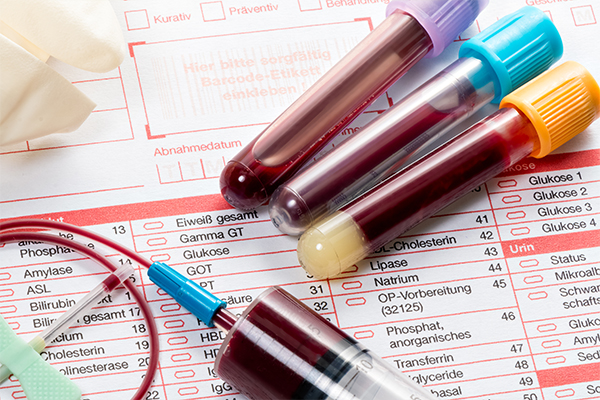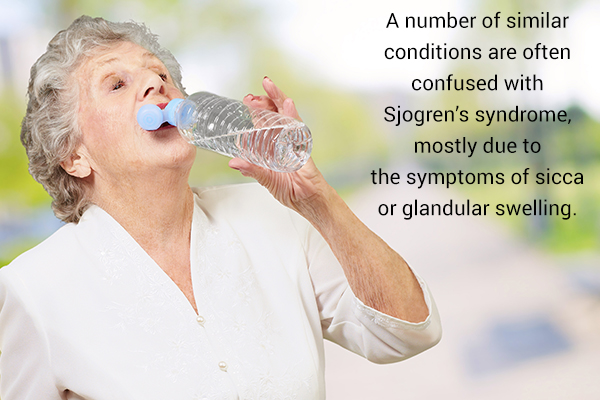In this article:
Sjogren’s syndrome is a multisystem, chronic autoimmune disease of unknown cause.

It frequently occurs in conjunction with other autoimmune syndromes, such as lupus or rheumatoid arthritis, in which case, it is often termed secondary Sjogren’s syndrome.
When presenting as a distinct illness, it is sometimes called Sjogren’s disease or primary Sjogren’s syndrome.
Body Parts Affected by Sjogren’s Syndrome
Sjogren’s syndrome may affect many body systems, including the lungs and respiratory system, gastrointestinal system, joints, and nervous system.
Sjogren’s syndrome often emerges insidiously. It develops gradually with a host of seemingly disparate symptoms that may not be recognized as representatives of a single syndrome.
As such, the diagnosis is often delayed and even missed by physicians.
Prevalence of Sjogren’s Syndrome
Sjogren’s syndrome is not a common disorder, as evidenced by the following facts:
- The prevalence of this condition is estimated to be 40–90 cases per 100,000 population. (1)
- Women are affected more often than men by a factor of 7–20. It most commonly manifests in women in their 50s and 60s. (2)
- Complaints of dry eye and mouth are quite common, especially in older individuals, where up to 30% of the elderly may experience sicca symptoms. (3)
Because most cases are due to other causes, Sjogren’s syndrome is often not recognized as a more serious explanation for dry eye and mouth symptoms.
Symptoms of Sjogren’s Syndrome

The hallmark of the condition is inflammation of the secretory glands, such as those responsible for saliva, perspiration, and tears. As a result, dryness of the eyes and mouth (sicca syndrome) along with dry and itchy skin is a common prominent symptom.
One of the reasons that the diagnosis of Sjogren’s syndrome is so challenging is that the symptoms and severity of the condition are so variable.
- Some patients experience mild ocular dryness and fatigue with aches and pains.
- Others may have disabling arthritis or respiratory, nervous, or intestinal system involvement.
- In some instances, patients become seriously ill, with compromising lung disease, severe neuropathy, and even non-Hodgkin’s lymphoma.
Other common symptoms include:
- Fatigue and low energy
- Joint pains
- Weakness
- Dry cough
- Corneal injury and keratoconjunctivitis sicca, often affecting vision
- Swollen lymph nodes
- Anemia and low white blood cell count
- Salivary gland swelling, often with pain and tenderness
- Indigestion, irritable bowel, difficulty swallowing, esophageal reflux, and other gastrointestinal problems
- Memory loss and brain fog
- Burning or tingling pains in the extremities
- Dry, itchy skin
- Vaginal dryness with resulting urinary and sexual difficulties
- Interstitial cystitis
- Liver problems, which range from mild liver test abnormalities to chronic autoimmune hepatitis
- Dental problems, such as tooth decay and periodontitis, due to loss of saliva
- Loss of sense of smell and taste
- Swollen glands, both lymph nodes, and salivary glands
- An increased risk of lymphoma
Diagnosis of Sjogren’s Syndrome

Most patients with mild to moderate Sjogren’s syndrome have prominent sicca symptoms. Since dryness of the eyes and/or mouth is common, clinicians may fail to recognize that the symptoms represent a systemic and inflammatory disorder.
Instead, the symptoms may be attributed to aging or a side effect of medication prescribed for other reasons. Hence, a delay in diagnosis is a common problem for sufferers of Sjogren’s syndrome. (3)
The biggest challenge in diagnosing Sjogren’s syndrome is simply considering the diagnosis! The condition mimics many other disorders, such as fibromyalgia, chronic fatigue syndrome, symptomatic menopause, and adverse drug reactions.
Moreover, sicca symptoms of dry eyes and mouth are common complaints in older people and have many causes other than Sjogren’s. Consequently, doctors may not recognize the systemic and inflammatory process and may attribute the patient’s complaints to other causes.
But once the doctor considers the possibility of Sjogren’s syndrome after excluding other causes for the sicca symptoms, it can easily be diagnosed based on clinical features, blood tests, and in some cases, a biopsy of the salivary glands.
The diagnostic tests for Sjogren’s syndrome include:
1. Blood tests
Blood tests often reveal the presence of various autoantibodies, but these antibodies are not restricted to Sjogren’s syndrome alone and can be indicative of other problems, such as systemic lupus. (4)
Therefore, while the antibody tests are quite useful in investigating Sjogren’s syndrome, they cannot be depended upon solely for the diagnosis. Other useful but non-specific blood tests include markers of inflammation, such as ESR and C-reactive protein.
2. Eye tests
When complaints of dry eyes are considered, the Schirmer test is used to measure tear production. Ocular surface staining tests may be used to assess any damage to the corneal tissue. Usually, these tests are performed by ophthalmologists.
3. Salivary function tests
The salivary glands can also be tested to establish glandular hypofunction.
4. Imaging tests
Ultrasonography and nuclear imaging studies (technetium scanning) may be helpful. An MRI of the parotid glands (the large salivary glands located under each cheek, in front of the ear) can detect structural abnormalities.
5. Biopsy
Biopsy of a salivary gland may be employed to detect the presence of inflammation – infiltration of the tissue with lymphocytes. This test is positive in about 80% of individuals with Sjogren’s syndrome. (5)
However, this test can be quite painful, result in persistent lip numbness, and even produce a false negative in some cases. Hence, it is not performed unless absolutely necessary.
For instance, 20%–30% of individuals with Sjogren’s syndrome do not possess autoantibodies and therefore require a biopsy to confirm the illness. (6)
Conditions That Mimic Sjogren’s Syndrome

A number of similar conditions are often confused with Sjogren’s syndrome, mostly due to the symptoms of sicca or glandular swelling. It is important to consider these possibilities, as well.
1. Age-related sicca syndrome
Ocular and oral dryness is frequent among those over age 65 years, but without any associated systemic symptoms, autoantibodies, and markers of inflammation.
2. Sarcoidosis
This is an immunological disorder that often presents with sicca symptoms and swelling of the salivary and tear glands, as well as other systemic symptoms, such as fatigue, joint pains, and respiratory problems, so there may be considerable overlap.
3. IgG4-related disease
This is a rare inflammatory condition that affects the secretory glands along with many other body systems and can appear much like Sjogren’s syndrome, but the laboratory and biopsy features are substantially different.
4. Lymphoma
Cancer of the lymphatic system and leukemias affect the salivary glands and can present with swelling due to tumor infiltration of the glands.
5. Sialadenitis
This is an infection of the salivary glands that can trigger sicca symptoms. It is common in people with diabetes or a blocked salivary duct due to a stone or some other reason.
6. Hepatitis C and HIV
These conditions occasionally affect the salivary glands and present with swelling and sicca symptoms.
It is also important to recognize the presence of secondary Sjogren’s syndrome in patients with other rheumatic disorders, such as lupus, rheumatoid arthritis, and psoriatic arthritis.
This is important because some of the treatment options differ, and patients will benefit when an associated Sjogren’s disease is recognized and addressed.
Final Word
Sjogren’s syndrome is a challenging problem that is associated with a significant reduction in the quality of life. (7)
Fortunately, for most sufferers, the mortality rate is not much different from that of the general population, and there are methods to manage the condition and treat symptoms fairly effectively. However, there is increased mortality in patients with severe conditions, such as those with interstitial lung disease, kidney disease, or lymphoma.

- Was this article helpful?
- YES, THANKS!NOT REALLY


